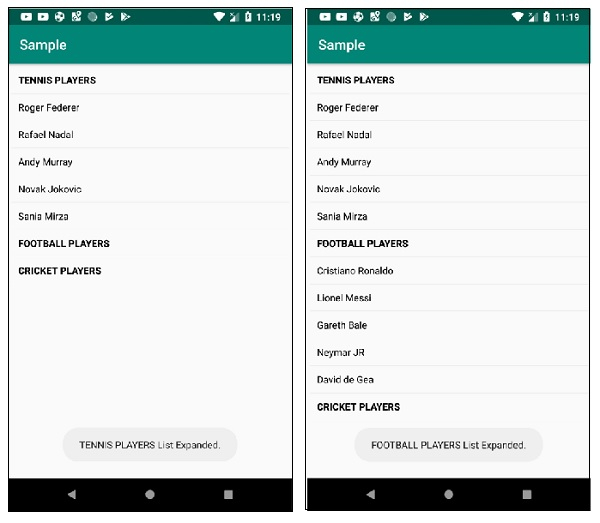
 Data Structure
Data Structure Networking
Networking RDBMS
RDBMS Operating System
Operating System Java
Java MS Excel
MS Excel iOS
iOS HTML
HTML CSS
CSS Android
Android Python
Python C Programming
C Programming C++
C++ C#
C# MongoDB
MongoDB MySQL
MySQL Javascript
Javascript PHP
PHP
- Selected Reading
- UPSC IAS Exams Notes
- Developer's Best Practices
- Questions and Answers
- Effective Resume Writing
- HR Interview Questions
- Computer Glossary
- Who is Who
How to create a multilevel ListView in an Android app?
This example demonstrates how do I create a multilevel listView in android.
Step 1 − Create a new project in Android Studio, go to File ⇒ New Project and fill all required details to create a new project.
Step 2 − Add the following code to res/layout/activity_main.xml.
<?xml version="1.0" encoding="utf-8"?> <RelativeLayout xmlns:android="http://schemas.android.com/apk/res/android" xmlns:tools="http://schemas.android.com/tools" android:layout_width="match_parent" android:padding="4dp" android:layout_height="match_parent" tools:context=".MainActivity"> <ExpandableListView android:id="@+id/expendableList" android:layout_width="match_parent" android:layout_height="match_parent" android:divider="@android:color/background_light" android:dividerHeight="0.5dp"/> </RelativeLayout>
Step 3 − Add the following code to src/MainActivity.java
import androidx.appcompat.app.AppCompatActivity;
import android.os.Bundle;
import android.view.View;
import android.widget.ExpandableListAdapter;
import android.widget.ExpandableListView;
import android.widget.Toast;
import java.util.ArrayList;
import java.util.HashMap;
import java.util.List;
public class MainActivity extends AppCompatActivity {
ExpandableListView expandableListView;
ExpandableListAdapter expandableListAdapter;
List<String>expandableListTitle;
HashMap<String, List<String>> expandableListDetail;
@Override
protected void onCreate(Bundle savedInstanceState) {
super.onCreate(savedInstanceState);
setContentView(R.layout.activity_main);
expandableListView = findViewById(R.id.expendableList);
expandableListDetail = ExpandableListData.getData();
expandableListTitle = new ArrayList<>(expandableListDetail.keySet());
expandableListAdapter = new CustomExpandableListAdapter(this, expandableListTitle, expandableListDetail);
expandableListView.setAdapter(expandableListAdapter);
expandableListView.setOnGroupExpandListener(new ExpandableListView.OnGroupExpandListener() {
@Override
public void onGroupExpand(int groupPosition) {
Toast.makeText(getApplicationContext(), expandableListTitle.get(groupPosition)
+ " List Expanded.", Toast.LENGTH_SHORT).show();
}
});
expandableListView.setOnGroupCollapseListener(new ExpandableListView.OnGroupCollapseListener() {
@Override
public void onGroupCollapse(int groupPosition) {
Toast.makeText(getApplicationContext(), expandableListTitle.get(groupPosition) + " List Collapsed.",
Toast.LENGTH_SHORT).show();
}
});
expandableListView.setOnChildClickListener(new ExpandableListView.OnChildClickListener() {
@Override
public boolean onChildClick(ExpandableListView parent, View v, int groupPosition, int childPosition, long id) {
Toast.makeText( getApplicationContext(), expandableListTitle.get(groupPosition) + "
-> " + expandableListDetail.get( expandableListTitle.get(groupPosition)).get( childPosition), Toast.LENGTH_SHORT ).show();
return false;
}
});
}
}
Step 4 − Create a java class (ExpandableListData.java) and the following code
import java.util.ArrayList;
import java.util.HashMap;
import java.util.List;
class ExpandableListData {
static HashMap<String, List<String>> getData() {
HashMap<String, List<String>> expandableListDetail = new HashMap<>();
List<String> myFavCricketPlayers = new ArrayList<>();
myFavCricketPlayers.add("MS.Dhoni");
myFavCricketPlayers.add("Sehwag");
myFavCricketPlayers.add("Shane Watson");
myFavCricketPlayers.add("Ricky Ponting");
myFavCricketPlayers.add("Shahid Afridi");
List<String> myFavFootballPlayers = new ArrayList<String>();
myFavFootballPlayers.add("Cristiano Ronaldo");
myFavFootballPlayers.add("Lionel Messi");
myFavFootballPlayers.add("Gareth Bale");
myFavFootballPlayers.add("Neymar JR");
myFavFootballPlayers.add("David de Gea");
List<String> myFavTennisPlayers = new ArrayList<String>();
myFavTennisPlayers.add("Roger Federer");
myFavTennisPlayers.add("Rafael Nadal");
myFavTennisPlayers.add("Andy Murray");
myFavTennisPlayers.add("Novak Jokovic");
myFavTennisPlayers.add("Sania Mirza");
expandableListDetail.put("CRICKET PLAYERS", myFavCricketPlayers);
expandableListDetail.put("FOOTBALL PLAYERS", myFavFootballPlayers);
expandableListDetail.put("TENNIS PLAYERS", myFavTennisPlayers);
return expandableListDetail;
}
}
Step 5 − Create a java class (CustomExpandableListAdapter.java) and the following code
package app.com.sample;
import android.content.Context;
import android.graphics.Typeface;
import android.view.LayoutInflater;
import android.view.View;
import android.view.ViewGroup;
import android.widget.BaseExpandableListAdapter;
import android.widget.TextView;
import java.util.HashMap;
import java.util.List;
import java.util.Objects;
class CustomExpandableListAdapter extends BaseExpandableListAdapter {
private Context context;
private List<String> expandableListTitle;
private HashMap<String, List<String>> expandableListDetail;
CustomExpandableListAdapter(Context context, List<String> expandableListTitle, HashMap<String, List<String>> expandableListDetail) {
this.context = context;
this.expandableListTitle = expandableListTitle;
this.expandableListDetail = expandableListDetail;
}
@Override
public Object getChild(int listPosition, int expandedListPosition) {
return
Objects.requireNonNull(this.expandableListDetail.get(this.expandableListTitle.get(list Position))).get(expandedListPosition);
}
@Override
public long getChildId(int listPosition, int expandedListPosition) {
return expandedListPosition;
}
@Override
public View getChildView(int listPosition, final int expandedListPosition, boolean isLastChild, View convertView, ViewGroup parent) {
final String expandedListText = (String) getChild(listPosition, expandedListPosition);
if (convertView == null) {
LayoutInflater layoutInflater = (LayoutInflater) this.context.getSystemService(Context.LAYOUT_INFLATER_SERVICE);
convertView = Objects.requireNonNull(layoutInflater).inflate(R.layout.list_row, null);
}
TextView textView = convertView.findViewById(R.id.listTitle);
textView.setText(expandedListText);
return convertView;
}
@Override
public int getChildrenCount(int listPosition) {
return
this.expandableListDetail.get(this.expandableListTitle.get(listPosition)).size();
}
@Override
public Object getGroup(int listPosition) {
return this.expandableListTitle.get(listPosition);
}
@Override
public int getGroupCount() {
return this.expandableListTitle.size();
}
@Override
public long getGroupId(int listPosition) {
return listPosition;
}
@Override
public View getGroupView(int listPosition, boolean isExpanded, View convertView, ViewGroup parent) {
String listTitle = (String) getGroup(listPosition);
if (convertView == null) {
LayoutInflater layoutInflater = (LayoutInflater) this.context. getSystemService(Context.LAYOUT_INFLATER_SERVICE);
convertView = Objects.requireNonNull(layoutInflater).inflate(R.layout.list_row, null);
}
TextView listTitleTextView = convertView.findViewById(R.id.listTitle);
listTitleTextView.setTypeface(null, Typeface.BOLD);
listTitleTextView.setText(listTitle);
return convertView;
}
@Override
public boolean hasStableIds() {
return false;
}
@Override
public boolean isChildSelectable(int listPosition, int expandedListPosition) {
return true;
}
}
Step 6 − Create a layout resource file(list_row.xml) and add the following code −
<?xml version="1.0" encoding="utf-8"?> <LinearLayout xmlns:android="http://schemas.android.com/apk/res/android" android:orientation="vertical" android:layout_width="match_parent" android:layout_height="match_parent"> <TextView android:id="@+id/listTitle" android:layout_width="fill_parent" android:layout_height="wrap_content" android:padding="10dp" android:textColor="@android:color/black" /> </LinearLayout>
Step 7 − Add the following code to androidManifest.xml
<?xml version="1.0" encoding="utf-8"?> <manifest xmlns:android="http://schemas.android.com/apk/res/android" package="app.com.sample"> <application android:allowBackup="true" android:icon="@mipmap/ic_launcher" android:label="@string/app_name" android:roundIcon="@mipmap/ic_launcher_round" android:supportsRtl="true" android:theme="@style/AppTheme"> <activity android:name=".MainActivity"> <intent-filter> <action android:name="android.intent.action.MAIN" /> <category android:name="android.intent.category.LAUNCHER" /> </intent-filter> </activity> </application> </manifest>
Let's try to run your application. I assume you have connected your actual Android Mobile device with your computer. To run the app from the android studio, open one of your project's activity files and click Run ![]() icon from the toolbar. Select your mobile device as an option and then check your mobile device which will display your default screen −
icon from the toolbar. Select your mobile device as an option and then check your mobile device which will display your default screen −


Click here to download the project code.

